
The Global Aquaculture Alliance’s (GAA) annual GOAL (Global Outlook for Aquaculture Leadership) conference begins today in Dublin, Ireland, at the city’s famed Croke Park, home of the Gaelic Athletic Association (the “other GAA”).
Editor James Wright will be covering the conference. Check back for blog updates throughout the three-day event and in-depth coverage in the days to come. Be sure to follow the Advocate on Twitter, using the hashtag #GOALConf17.
____________
GAA Executive Director Wally Stevens delivered the opening remarks, challenging attendees to take ownership of the industry’s mission to deliver credible assurances to the marketplace that their seafood is sustainably grown and responsibly harvested.
“There are people who love, who fight for and who are transformed by aquaculture,” he said. “Everything starts with vision, a fire in one’s head. Within me? It’s the future. We need to find ways to improve both wild fisheries and aquaculture and not one at the expense of the other.”
Invoking the literary greats of the host country Ireland, Stevens said aquaculture has many great expectations to fulfill, including a predictable supply of nutritious food at a predictable cost, respect for the environment and workers, as well as care for the animals being raised.
____________
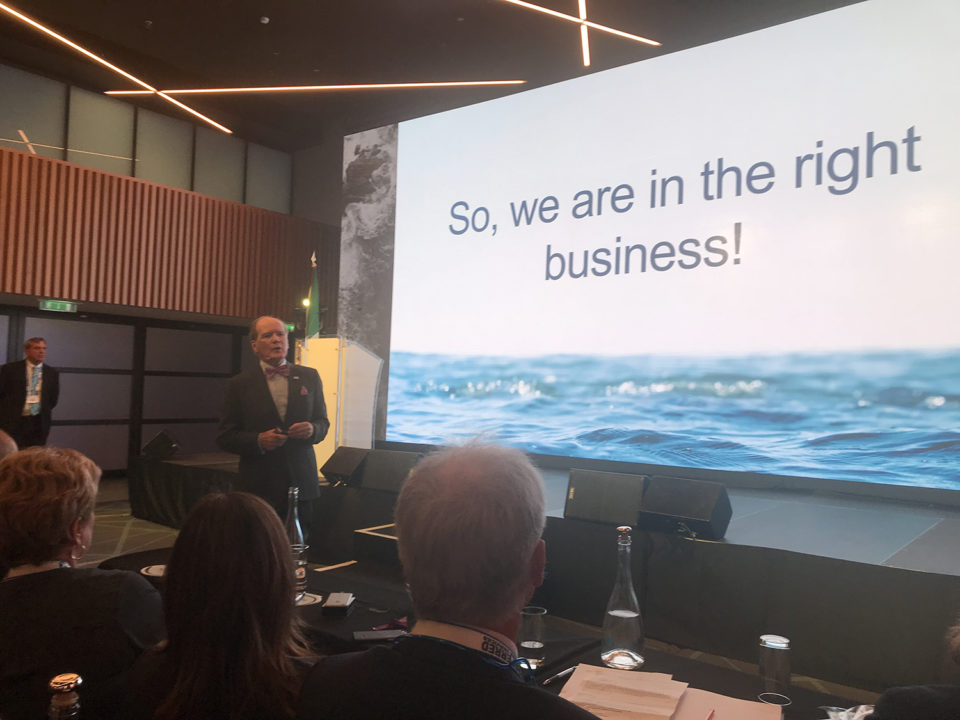
Ireland native Dr. Pearse Lyons, founder of animal health company Alltech, which employs more than 5,000 in 120-plus countries, delivered the keynote address, “The Future of Food, an Aquaculture Opportunity.”
Lyons, who built Alltech into a company with $2.1 billion in annual sales, talked about the challenges facing the “strange world” we live in, with a ballooning population, expected to reach 9.7 billion by 2050.
“It’s a world of community, collectivity, and a world of shifting populations,” said Lyons.
People need to be fed, and efficient use of resources will be crucial, he said. “We must not waste. What source of protein is most efficient? What’s the best use of our resources?”
Detailing the feed conversion ratios and greenhouse gas emissions of the beef, poultry and pork industries, Lyons said it is not a pretty picture. Aquaculture provides a better environmental story, but the seafood supply chain has numerous shortcomings it must overcome, including transparency and truthfulness.
Lyons hit on a wide range of topics, including some breakthroughs that Alltech has achieved. This year, the GeneChip for salmon and trout was completed, giving the industry a powerful tool to boost animal health and welfare.
“We can measure how genes are affected,” he said. “We can take one fish and predict with absolute certainty what will happen with 10,000.”
Perhaps most exciting was Lyons’ prediction that the industry could solve the sea lice problem in as little as six months with the help of this tool. “We will conquer sea lice in six months. We will do so because of what we’ve learned from the GeneChip.”
____________
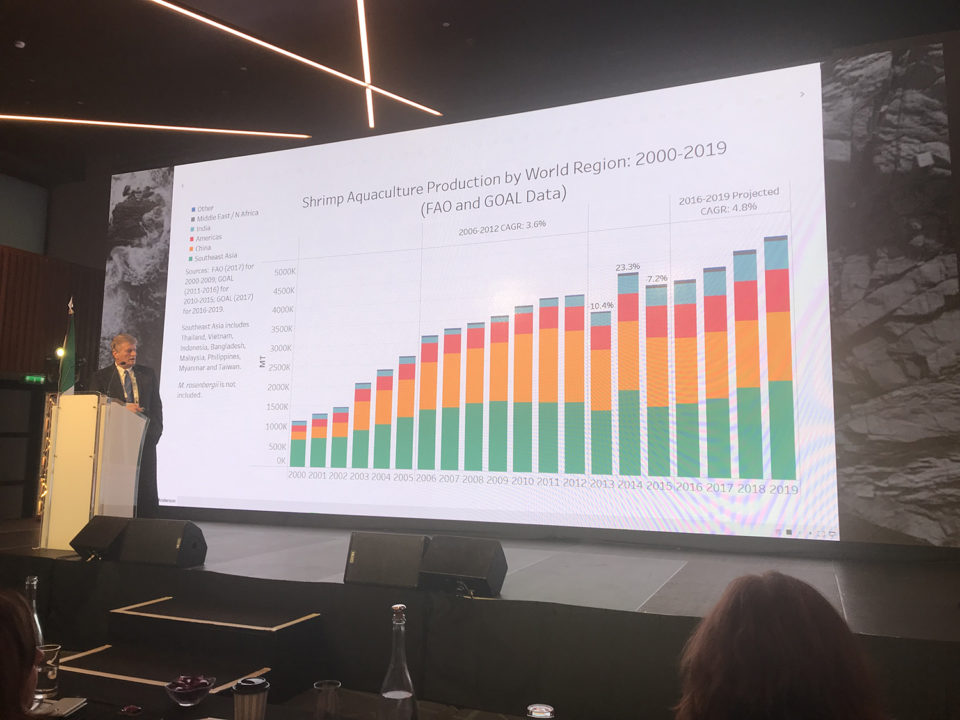
Jim Anderson, a professor and director of the Institute for Sustainable Food Systems at the University of Florida, said global shrimp production is forecast to increase 4.8 percent from 2016 to 2019.
Anderson’s global farmed shrimp production data is based on surveys of dozens of producers, associations and government agencies worldwide.
The surveys are administered annually by Dr. Darryl Jory, editor emeritus of the Advocate.
“I’m an economist. Most of us believe that an efficient, functioning market is the most essential feature of our economy. If it’s not efficient and working clearly you have problems,” said Anderson. “My noble goal is to bring some transparency to the sector so you can make better decisions.”
Anderson highlighted production growth in India (11.2 percent) and in pockets of South America.
“Ecuador obviously is growing very nicely right now,” he said, pointing to production that has exceeded 450,000 metric tons (MT). “In contrast, Mexico and Brazil are not living up to their expectations.”
About 53.7 percent of global shrimp production is from aquaculture. Anderson pointed out that the bulk of wild shrimp is for industrial purposes and does not compete with farmed product.
Anderson ran through some trends in the global shrimp trade and the data showed that U.S. shrimp imports, which fell 12 percent from 2011 to 2013, largely due to disease issues, increased 31 percent between 2013 and 2017.
Regarding the key constraints facing shrimp production, the top three are disease, availability of seed stock quality and access to disease-free broodstock.
____________
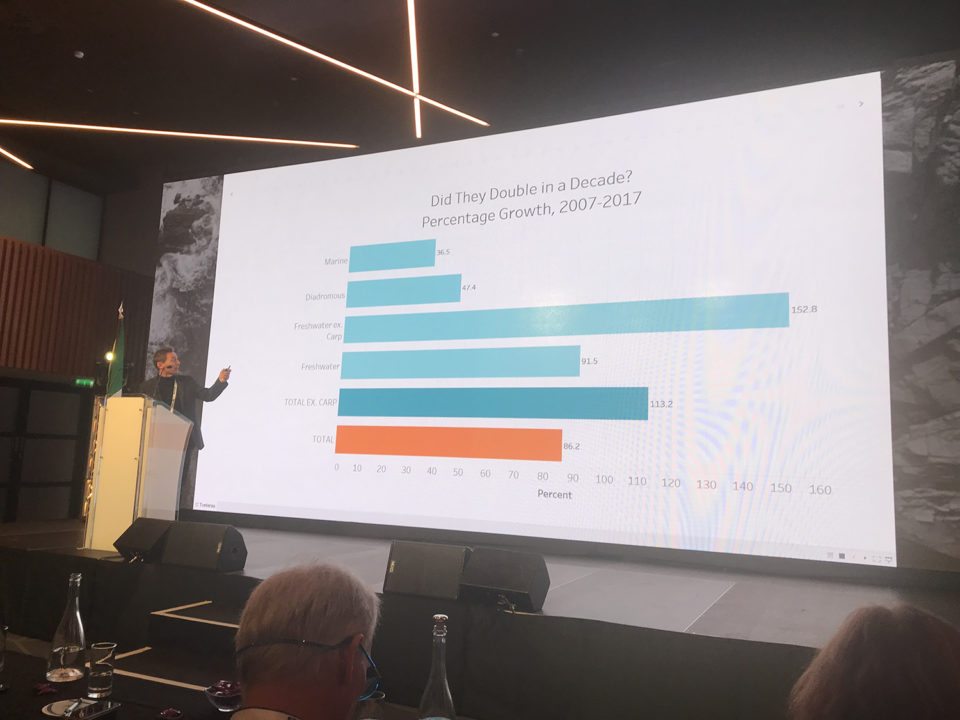
Ragnar Tveteras, an economist and professor at the University of Stavanger’s Department for Industrial Economics, Risk Management and Planning in Norway, presented analyze exclusive data on global farmed finfish production.
The data is based on surveys of dozens of producers, associations and government agencies worldwide, administered annually by GAA’s Dr. Darryl Jory, with contributions from Ragnar Nystoyl of Kontali Analyse.
With a lot of ground to cover, Tveteras whipped through the data at breakneck speed, but here are a few highlights:
- Catfish production reached levels of 5.3 million MT, up 9 percent, with predictions of 8 percent growth to 5.7 million MT next year.
- Carp production, dominated by China at 75 percent of the projected total in 2017, will increase 5 percent next year to nearly 30 million MT.
- Norway’s salmon production should hit 1.2 million MT, with predictions to increase an additional 7 percent next year.
- Cobia estimated to reach 45,000 MT in 2017, while bluefin tuna should hit 58,120 MT this year.
“Sea bass and sea bream, for many years, has not been able to take off from levels from 300,000 [MT], but this year it seems that production is estimated to increase 11 percent to nearly 350,000 [MT],” said Tveteras.
Total finfish production will hit 43.89 million MT, including carps, said Tveteras. Excluding carps, the total will hit just 15.68 million MT, illustrating the massive size of China’s carp production. Next year’s forecast calls for 16.49 million MT, according to the survey data.
____________
GSSI benchmarks Best Aquaculture Practices standards
The Global Sustainable Seafood Initiative (GSSI) announced that GAA’s Best Aquaculture Practices (BAP) is the world’s first aquaculture certification program to be recognized as a credible scheme in alignment with the FAO Technical Guidelines on Aquaculture Certification.
BAP is the first aquaculture certification scheme to earn GSSI recognition. To read more, click here.
____________
Guangdong Evergreen Feed Industry Co., Ltd. (Evergreen) was named the winner of the inaugural F3 Challenge, a global contest to drive innovation in the aquafeed sector and reduce the aquaculture industry’s reliance on marine ingredients like fishmeal and fish oil.
For further details, please click here.
____________
IFFO: F3 contest ‘demonized’ marine ingredients
During a panel presentation on the future of aquafeeds, Andrew Mallison of IFFO-The Marine Ingredients Organisation, said the F3 contest “demonized” the fishmeal and fish oil industries with its messaging for its inaugural fish-free feed contest.
“Forty-five percent of the world’s fishmeal and fish oil production is certified under the [IFFO Responsible Supply] scheme,” said Mallison. “Being called cancer doctors is not something I was expecting. Backhanded compliment. Eloquent way of giving us a bit of a slap.”
Mallison was responding to University of Arizona Professor Kevin Fitzsimmons, who used the comparison in an attempt to compliment the work that IFFO has done to drive out overfishing and illegal fishing (see below), while stressing that fishmeal and fish oil alternatives are necessary to grow aquaculture globally.
IFFO has repeatedly stated that the emergence of alternative feed ingredients – soy, insect meal, single-cell organisms and marine algae – should be characterized as supplementing the overall supply of aquafeed ingredients, not replacing fishmeal and fish oil, which Mallison stressed are crucial to the future of aquaculture as well.
“[Fishmeal and fish oil] availability is going up. We’re recovering more byproducts. There are 12 million metric tons of byproducts available. There are logistics to tackle, but 35 of the current supply is from byproducts and will go past 50 percent in next five years,” said Mallison.
“Our supply is unlikely to meet the [overall] demand; we need the alternative ingredients. We welcome the campaign. But the F3 campaign has demonized the industry. We’re all trying to see the industry go forward, welcoming alternatives, yet the F3 campaign is trying to narrow those choices on dubious claims.”
Here are Fitzsimmons’ remarks at the onset of the panel discussion:
“I appreciate and applaud what IFFO are doing for forage fisheries around the world. They are reforming an industry that really needs it. As far as I’m concerned, they’re like cancer doctors, trying to cut out overfishing, IUU fishing from around the world, the problems of slave labor, forced labor. Doing great things, but fighting cancer is expensive. As we get more responsible fisheries, it’s imperative that we find alternatives.”
____________
Economist Jim Power kicked off Day 2 of GOAL with an overview of macroeconomic trends impacting the distribution and sale of farmed seafood products. The Irish native was keen to point out that Brexit – Britain’s exit from the European Union, voted on in referendum last year – was having a huge impact on the Pound Sterling.
“The markets don’t like Sterling. From an Irish perspective, it exacerbates the uncertainty over Brexit,” Power said. “It’s the job of economists to dampen spirits. What Brexit and Trump proved was the rejection of conventional politics. [Both cases] were electorates giving two fingers to the conventional political system.”
The rise of protectionism and trend away from free trade agreements such as NAFTA and TPP have potentially serious repercussions on the global economy and could restrict trade in the future, he surmised.
Shifting global demographics are another factor causing “dangerous tensions” in the EU. Fifty percent of global population growth is expected to come from just nine countries, most on African continent. This will have massive implications for food production and consumption, said Power.
Closer to home, Irish consumers want cheap food, which creates a dilemma between price, quality, uniqueness and, by implication, food safety.
“For anybody in the food production business, it’s a challenging environment,” he said. “Population growth [will lead to] a 60 percent increase in agricultural consumption. [Food is] a sector with a good future but in an environment of limited pricing power and more volatile prices, efficiency in production will be key to success.”
____________
Gorjan Nikolik, senior industry analyst for Rabobank, said aquaculture is challenged by two major factors: the high price of feed in the sector and high mortality and biological costs.
“The solutions is novel feed ingredients,” he said, referring to algae, insects and single-cell organisms that are gaining steam and attracting investors. “The tools at hand all lack something.”
Alternative ingredients that can supplement the traditional aquafeed ingredients, mainly fishmeal and fish oil, often lack the full nutritional package, or are expensive. Even seafood processing byproducts pose specific challenges.
“Trimmings are hard to get or not allowed,” he said.
Nikolik was buoyed by what he called a “proliferation of innovation” in the sector. “The last two or three years have been a boom.”
If asked to pick a winner in the short term, Nikolik said microalgae makes a lot of sense, for it has the essential omega-3 fatty acids not found in other alternatives.
“The next period is essential for alternative ingredient producers – those that have big pockets, or strong financial partners, might consolidate the others; those with a great niche strategy; and those that have a long-term view.”
____________
On the third and final day of GOAL, Johnson & Wales University professor and seafood industry veteran Jim Griffin ran though the results of a 2017 survey of UK chefs and found that there was enormous opportunity to educate them about sustainability.
In the 95 qualified responses, it was clear that their understanding of sustainability was “very mixed,” said Griffin.
Two-thirds of chefs agreed that sales of seafood were on the rise in the U.K. and that sustainability was very important. However, only 58 percent of the chefs recognized the Best Aquaculture Practices eco-label, and only a small portion of them had the correct answer as to what the eco-label truly meant.
“Eco-labeling is critically important to what we’re doing, in terms of integrity,” said Griffin, who concluded that only one-third of chefs had a positive opinion of farmed seafood. “This is a huge opportunity [to educate].”
“There is still a negative impression of aquaculture,” said JP McMahon, who runs the Irish restaurants Aniar, Cava and Eat Gastropub. “However, our oysters and our mussels are farmed and there’s no negative impression of that at all. As they try to build a salmon farm off of Galway, theres’s an absolute riot.”
Now that you've reached the end of the article ...
… please consider supporting GSA’s mission to advance responsible seafood practices through education, advocacy and third-party assurances. The Advocate aims to document the evolution of responsible seafood practices and share the expansive knowledge of our vast network of contributors.
By becoming a Global Seafood Alliance member, you’re ensuring that all of the pre-competitive work we do through member benefits, resources and events can continue. Individual membership costs just $50 a year.
Not a GSA member? Join us.
Author
-
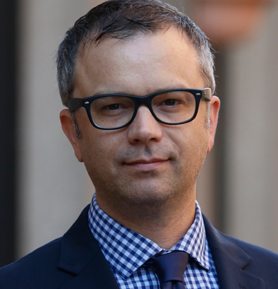
James Wright
Editorial Manager
Global Aquaculture Alliance
Portsmouth, NH, USA
Tagged With
Related Posts
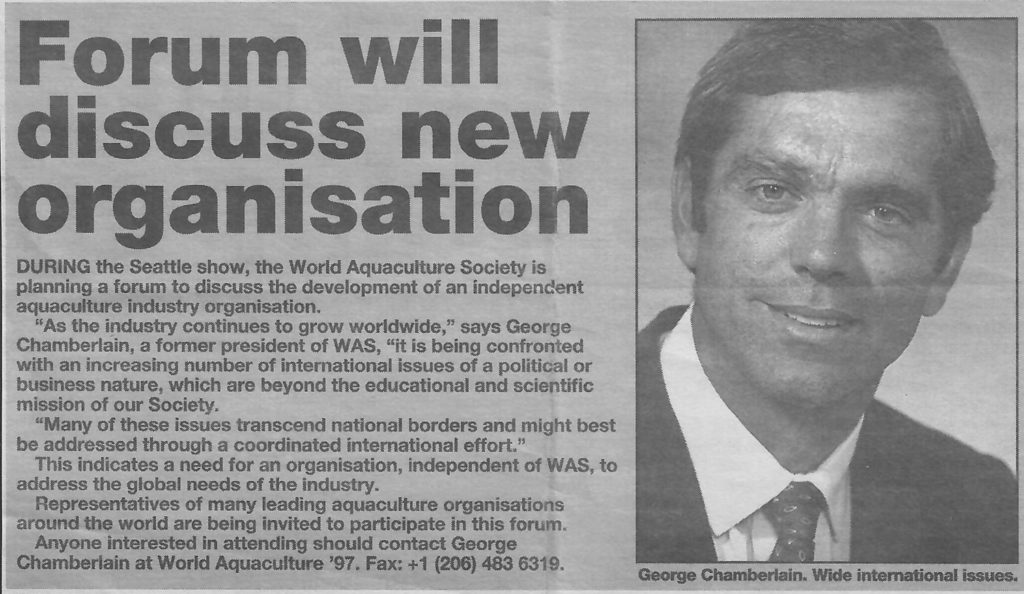
Innovation & Investment
20 years of the Global Aquaculture Alliance
A timeline of key milestones and achievements by the Global Aquaculture Alliance and its third-party aquaculture certification scheme, Best Aquaculture Practices (BAP).
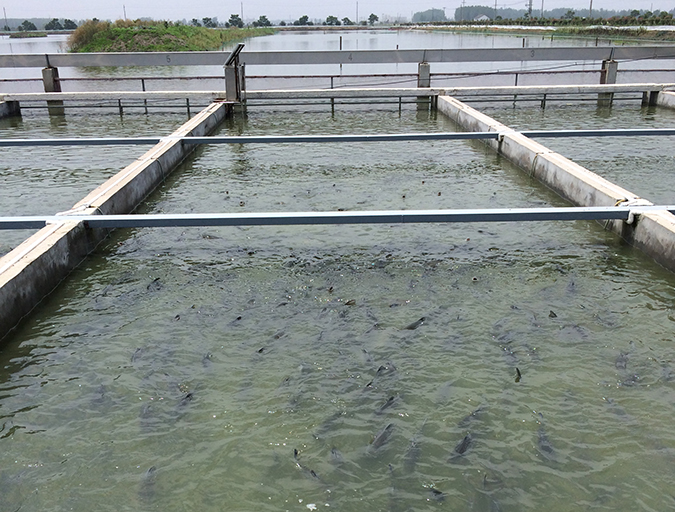
Innovation & Investment
GOAL 2016 preview: IPA technology catching on in China
Intensive pond aquaculture (IPA) technology, a floating, in-pond raceway system developed in the United States, is being adopted fast in China, just three years after its introduction, says Jim Zhang, aquaculture program manager for USSEC-China.
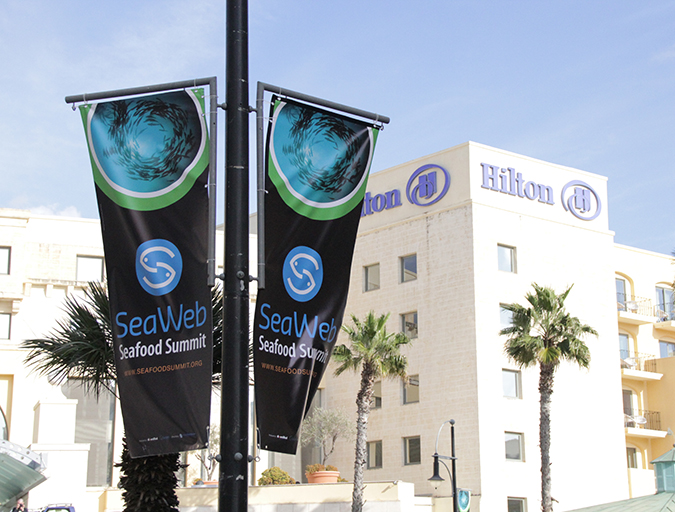
Responsibility
GSSI furthers its mission of clarity out of confusion
The Global Sustainable Seafood Initiative aims to set the bar for certification schemes. Board members of the task force formed in 2012 convened at the SeaWeb Seafood Summit in Malta to reinforce the mission and brief attendees on progress.
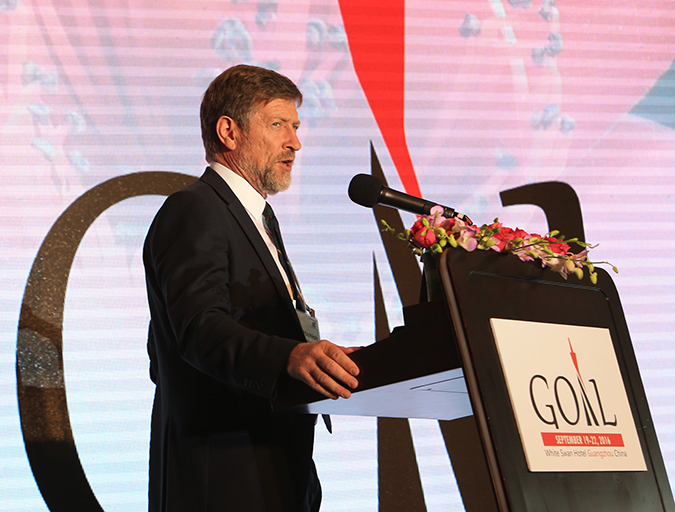
Health & Welfare
Healthy fish: Recap of Day 1 at GOAL 2016
Some of the world’s top aquatic animal disease experts shared knowledge about mitigation techniques at the GOAL conference in Guangzhou, China. Topics included sea lice, streptococcus and EHP, which was referred to as the “most insidious” disease impacting shrimp production.


